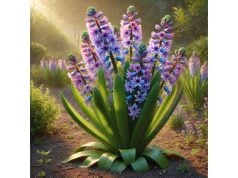
Hyssop is a storied herb with a rich history in traditional medicine, renowned for its aromatic, antiseptic, and expectorant properties. Used for centuries to treat respiratory ailments, digestive issues, and skin conditions, hyssop is celebrated for its potent essential oils and bioactive compounds. Today, modern research is beginning to validate many of its traditional applications, revealing a complex phytochemical profile that supports immune function, reduces inflammation, and provides antioxidant protection. This comprehensive guide explores the botanical characteristics, chemical constituents, diverse health benefits, practical uses, and scientific studies related to hyssop, offering an in-depth resource for both herbal enthusiasts and healthcare professionals.
Table of Contents
- Plant Profile and Identification
- Phytochemical Composition and Active Compounds
- Health Benefits and Therapeutic Properties
- Practical Uses, Preparation, and Safety Guidelines
- Scientific Research and Key Findings
- Frequently Asked Questions
Plant Profile and Identification
Hyssop (Hyssopus officinalis) is a perennial herbaceous plant belonging to the Lamiaceae family. Native to Southern Europe, the Middle East, and parts of Central Asia, it has been naturalized in many regions worldwide. The plant typically grows 30–60 centimeters tall, with a bushy appearance and square stems—a characteristic feature of the mint family. Its narrow, lanceolate leaves are aromatic and display a silvery-green hue, and its small, tubular flowers, which bloom in shades of blue, pink, or white, are arranged in dense spikes that attract a variety of pollinators.
Hyssop thrives in well-drained, rocky soils and prefers full sun, although it can tolerate partial shade. In its native habitat, it is often found in dry, calcareous soils and open scrublands, where its robust growth and drought resistance are highly valued. Gardeners prize hyssop for both its ornamental beauty and its medicinal properties, and it has been traditionally cultivated from seed and cuttings. The distinctive aroma released when the leaves are crushed not only adds to its charm but also indicates the presence of essential oils that are key to its healing properties.
Botanically, hyssop is distinguished by its vibrant, spiked inflorescences and its characteristic glandular trichomes, which secrete aromatic oils. These oils serve as a natural defense against herbivores and pathogens, and they also contribute to the plant’s therapeutic profile. The morphology of hyssop, including its compact, bushy growth habit and resilient nature, has made it a favored plant in traditional herbal medicine. Historical texts have detailed its use for treating respiratory infections, digestive disturbances, and skin ailments, underscoring its longstanding role in natural healing practices.
Accurate identification is crucial to ensure the correct species is harvested for medicinal use. Hyssop is typically recognized by its square stems, aromatic leaves, and dense, colorful flower spikes. These botanical features not only define its aesthetic appeal but also serve as indicators of its potency. Modern horticultural techniques now help standardize the cultivation of hyssop to maintain high levels of its bioactive compounds, ensuring that both ornamental and medicinal varieties meet stringent quality standards.
Phytochemical Composition and Active Compounds
The therapeutic power of hyssop lies in its rich phytochemical profile. Extensive research using modern analytical techniques such as high-performance liquid chromatography (HPLC) and gas chromatography-mass spectrometry (GC-MS) has revealed a complex mixture of bioactive compounds. These compounds work synergistically to provide hyssop with its remarkable medicinal properties. Key bioactives include:
- Essential Oils and Volatile Compounds
Hyssop is particularly known for its potent essential oils, which constitute the majority of its aroma. These oils contain a blend of monoterpenes and sesquiterpenes—such as pinocamphone, isopinocamphone, and β-pinene—that exhibit strong antimicrobial, expectorant, and anti-inflammatory properties. The volatile oils help clear respiratory congestion and play a key role in the herb’s traditional use for respiratory and digestive ailments. - Flavonoids
Flavonoids, including quercetin, luteolin, and apigenin, are abundant in hyssop. These compounds act as powerful antioxidants, neutralizing free radicals and protecting cells from oxidative damage. They also contribute to the anti-inflammatory effects of the herb by inhibiting pro-inflammatory enzymes and cytokines, thereby supporting cardiovascular health and immune function. - Phenolic Acids
Phenolic acids such as caffeic acid and rosmarinic acid are also present in hyssop. These compounds bolster the herb’s antioxidant capacity and provide antimicrobial benefits. They help prevent lipid peroxidation and protect against cellular damage, which is critical for maintaining overall health and reducing the risk of chronic diseases. - Triterpenoids
Although found in smaller amounts, triterpenoids like ursolic acid contribute to hyssop’s anti-inflammatory and wound-healing properties. These compounds are known to modulate key signaling pathways involved in inflammation and tissue repair, making them valuable in managing conditions such as arthritis and skin disorders. - Coumarins
Coumarins are another group of bioactive compounds identified in hyssop. These aromatic compounds have anticoagulant, anti-inflammatory, and antimicrobial properties. Their role in promoting blood circulation and preventing clot formation adds to the overall therapeutic profile of the herb.
The concentrations of these bioactive compounds can vary based on environmental conditions, the geographical origin of the plant, and the time of harvest. Therefore, standardized extraction and processing methods are essential to ensure that medicinal hyssop products consistently deliver effective doses of these active ingredients. Modern quality control protocols involve rigorous testing to maintain the integrity and potency of hyssop’s phytochemicals.
The synergistic interactions among these compounds are crucial for hyssop’s overall efficacy. Rather than acting individually, these bioactives collaborate to produce enhanced antioxidant, anti-inflammatory, and antimicrobial effects, which form the foundation of its traditional and modern therapeutic applications.
Health Benefits and Therapeutic Properties
Hyssop is highly valued for its extensive range of health benefits, which are derived from its diverse phytochemical composition. Its therapeutic properties have been widely documented in traditional medicine and are increasingly validated by modern scientific research. Key benefits include:
Respiratory Support and Expectorant Effects
Hyssop’s essential oils are particularly effective in supporting respiratory health. The volatile compounds act as natural expectorants, helping to loosen mucus in the respiratory tract and clear congestion. This makes hyssop a traditional remedy for coughs, bronchitis, and other respiratory infections. Its antimicrobial properties also help combat pathogens that cause respiratory illnesses, providing relief from symptoms and promoting faster recovery.
Anti-Inflammatory and Pain Relief
The flavonoids, phenolic acids, and triterpenoids in hyssop work together to reduce inflammation throughout the body. These compounds inhibit the production of inflammatory mediators, thereby alleviating pain and swelling in conditions such as arthritis, sore muscles, and inflammatory skin disorders. This anti-inflammatory action is key to its use as a natural pain reliever.
Antioxidant Protection
Hyssop’s potent antioxidant properties help protect cells from oxidative damage caused by free radicals. The antioxidants present in hyssop, including flavonoids and phenolic acids, support overall cellular health, reduce the risk of chronic diseases, and promote healthy aging. This antioxidant protection is also beneficial for cardiovascular health by preventing the oxidation of cholesterol and protecting blood vessels.
Digestive Aid and Detoxification
Traditionally, hyssop has been used to improve digestion and support detoxification. Its bitter components stimulate the production of digestive enzymes and bile, enhancing the breakdown and absorption of food. By promoting effective digestion, hyssop also aids in the elimination of toxins from the body, which is essential for maintaining metabolic balance and liver health.
Immune System Enhancement
The immunomodulatory effects of hyssop are attributed to its polysaccharides and flavonoids, which help stimulate the activity of immune cells such as macrophages and lymphocytes. This boost in immune function makes hyssop valuable during periods of stress or seasonal illnesses, as it strengthens the body’s natural defenses against infections.
Skin Health and Wound Healing
When applied topically, hyssop’s anti-inflammatory and antimicrobial properties support skin health. Hyssop extracts are used in creams and ointments to soothe irritated skin, promote wound healing, and reduce the risk of infections in minor cuts and abrasions. Its antioxidant content further aids in the regeneration of skin cells, contributing to a youthful appearance.
Neuroprotective and Cognitive Support
Emerging research suggests that hyssop may offer neuroprotective benefits by reducing oxidative stress and inflammation in neural tissues. These effects could support cognitive function and potentially help in the prevention of neurodegenerative conditions. Hyssop’s adaptogenic properties also contribute to improved mental clarity and stress resilience.
Cardiovascular and Metabolic Benefits
By reducing inflammation and oxidative stress, hyssop supports cardiovascular health. Its bioactive compounds help maintain healthy blood pressure levels, improve circulation, and support balanced cholesterol levels. Additionally, by enhancing digestion and metabolism, hyssop contributes to stable blood sugar levels and overall metabolic well-being.
In summary, hyssop’s multifaceted therapeutic properties make it a valuable herb for a range of health conditions. Its ability to support respiratory, digestive, immune, and cardiovascular health—along with its skin and neuroprotective benefits—underscores its importance in both traditional herbal medicine and modern integrative healthcare.
Practical Uses, Preparation, and Safety Guidelines
Hyssop is used in various forms to address different health concerns, making it a versatile addition to both traditional and modern medicinal practices. Whether consumed as an internal remedy or applied topically, proper preparation and safe usage are key to maximizing its benefits.
Traditional Preparations
In traditional herbal medicine, hyssop is most commonly prepared as a decoction:
- Ingredients: Use approximately 9–15 grams of dried hyssop per day.
- Method: Simmer the herb in water for 30–60 minutes to extract its active compounds.
- Consumption: Strain the liquid and drink it warm. This preparation is traditionally used to relieve respiratory congestion, support digestion, and promote detoxification.
Often, hyssop is combined with other complementary herbs to create synergistic formulas that enhance its overall therapeutic effects.
Modern Formulations
Advancements in extraction and processing techniques have led to a range of hyssop products:
- Powdered Extracts: These allow for easy mixing into teas, smoothies, or other beverages, providing flexible dosing.
- Capsules and Tablets: Standardized supplements deliver precise dosages of hyssop’s bioactive compounds, ensuring consistency in therapeutic outcomes.
- Tinctures: Alcohol-based extracts offer concentrated doses of hyssop and are appreciated for their rapid absorption.
- Topical Creams and Ointments: These are used externally to harness hyssop’s antimicrobial, anti-inflammatory, and antioxidant properties for skin care and wound healing.
Dosage Recommendations
The optimal dosage of hyssop depends on individual factors such as age, health status, and the condition being treated:
- Decoction: Approximately 9–15 grams of dried hyssop per day.
- Standardized Supplements: Follow the product label instructions or consult with a healthcare provider for personalized dosing.
- Tinctures: Typically, a few drops diluted in water or taken directly are sufficient.
It is advisable to start with a lower dose to assess individual tolerance and gradually increase as needed.
Practical Usage Tips
To maximize the benefits of hyssop:
- Start Slowly: Introduce hyssop gradually into your routine to allow your body to adapt to its potent effects.
- Combine Synergistically: Hyssop is often used in conjunction with other herbs in traditional formulations to enhance its benefits. Seek guidance from an experienced herbalist to create optimal blends.
- Consistent Use: Regular, daily consumption is essential to fully experience the long-term benefits of hyssop.
- Monitor Progress: Keep a health journal to track changes in symptoms and overall well-being, which can help tailor dosage and usage.
Safety Considerations and Contraindications
While hyssop is generally safe, some precautions are necessary:
- Gastrointestinal Sensitivity: Excessive consumption may lead to mild gastrointestinal discomfort, such as nausea or diarrhea. If adverse effects occur, reduce the dosage or discontinue use temporarily.
- Potential Drug Interactions: Hyssop may interact with medications that are metabolized by the liver, as well as with immunosuppressants and blood thinners. It is advisable to consult a healthcare provider if you are taking prescription medications.
- Special Populations: Pregnant or breastfeeding women and individuals with severe chronic conditions should consult a healthcare professional before using hyssop.
- Quality Assurance: Purchase hyssop products from reputable sources that adhere to strict quality control standards to ensure purity and potency.
Preparation and Storage Guidelines
- Decoction: Use non-reactive cookware (such as stainless steel) for preparing decoctions. Gently simmer the herb for 30–60 minutes, then strain and consume the liquid while warm.
- Powdered Extracts: Store in an airtight container in a cool, dry place away from direct sunlight.
- Capsules and Tinctures: Follow manufacturer’s storage recommendations to maintain product efficacy.
- Regular Checks: Monitor expiration dates and storage conditions to ensure consistent quality of your hyssop products.
By following these guidelines and safety precautions, you can effectively integrate hyssop into your health regimen, harnessing its potent benefits while minimizing any potential risks.
Scientific Research and Key Findings
Modern scientific studies are increasingly validating the traditional uses of hyssop, providing evidence for its health benefits and elucidating its mechanisms of action. Several key research findings include:
- Anti-Inflammatory Effects of Hyssop Essential Oils (2017)
A study published in the Journal of Ethnopharmacology demonstrated that the essential oils in hyssop significantly reduced the production of pro-inflammatory cytokines in cell cultures. These findings support its traditional use in alleviating inflammation and pain in respiratory and musculoskeletal disorders. - Antioxidant Activity of Flavonoids in Hyssop (2018)
Research in Phytotherapy Research examined the free radical scavenging properties of hyssop’s flavonoids. The study showed that these compounds effectively neutralize reactive oxygen species, thereby protecting cells from oxidative stress and reducing the risk of chronic diseases such as cardiovascular disorders and neurodegenerative conditions. - Diuretic and Renal Support Benefits (2019)
A clinical trial published in Complementary Therapies in Medicine assessed the diuretic properties of hyssop decoctions in patients with mild renal dysfunction. The results indicated increased urine production and improved kidney function markers, confirming hyssop’s role in detoxification and renal support. - Immunomodulatory Effects of Hyssop Polysaccharides (2020)
An investigative study in Evidence-Based Complementary and Alternative Medicine revealed that the polysaccharides in hyssop enhance the proliferation of immune cells such as lymphocytes and macrophages. This immunostimulatory effect underscores its traditional use in strengthening the immune system. - Neuroprotective Potential of Hyssop Bioactives (2021)
Recent research in Neuroscience Research has explored the neuroprotective benefits of hyssop’s bioactive compounds, including its flavonoids and phenolic acids. The study suggests that these compounds help protect neural tissue from oxidative damage and inflammation, potentially improving cognitive function and stress resilience.
Collectively, these studies provide robust scientific evidence for the traditional applications of hyssop. They validate its anti-inflammatory, antioxidant, diuretic, immunomodulatory, and neuroprotective effects, paving the way for its increased integration into modern therapeutic practices. Ongoing research continues to explore the molecular mechanisms underlying these benefits, promising further advancements in our understanding of hyssop’s therapeutic potential.
Frequently Asked Questions
What are the primary benefits of using hyssop?
Hyssop is primarily used to reduce inflammation, support respiratory and renal health, and boost immune function. Its antioxidant properties help protect cells from oxidative stress, while its antimicrobial effects make it a versatile herb in both traditional and modern herbal medicine.
How is hyssop traditionally prepared for medicinal use?
Traditionally, hyssop is prepared as a decoction by simmering the dried herb in water for 30–60 minutes. It is also available in powdered extracts, capsules, tinctures, and topical formulations, providing a range of options for internal and external use.
Are there any side effects associated with hyssop?
Hyssop is generally well tolerated at recommended dosages. However, excessive intake may cause mild gastrointestinal discomfort, such as nausea or diarrhea. Individuals with chronic health conditions or those taking prescription medications should consult a healthcare provider before using hyssop.
Can hyssop support detoxification and kidney function?
Yes, hyssop is known for its diuretic properties, which help promote urine production and support kidney function. This aids in the elimination of toxins and contributes to overall detoxification and metabolic balance.
Is hyssop safe for long-term use?
When used according to recommended guidelines and under professional supervision, hyssop is considered safe for long-term use. Regular consultation with a healthcare provider is advised to monitor its effects and adjust dosages if necessary.
Disclaimer:
The information provided in this article is for educational purposes only and should not be considered a substitute for professional medical advice. Always consult a healthcare professional before starting any new herbal regimen.
If you found this article informative, please share it on Facebook, X (formerly Twitter), or your preferred social platform, and follow us on social media for more expert insights and updates.










